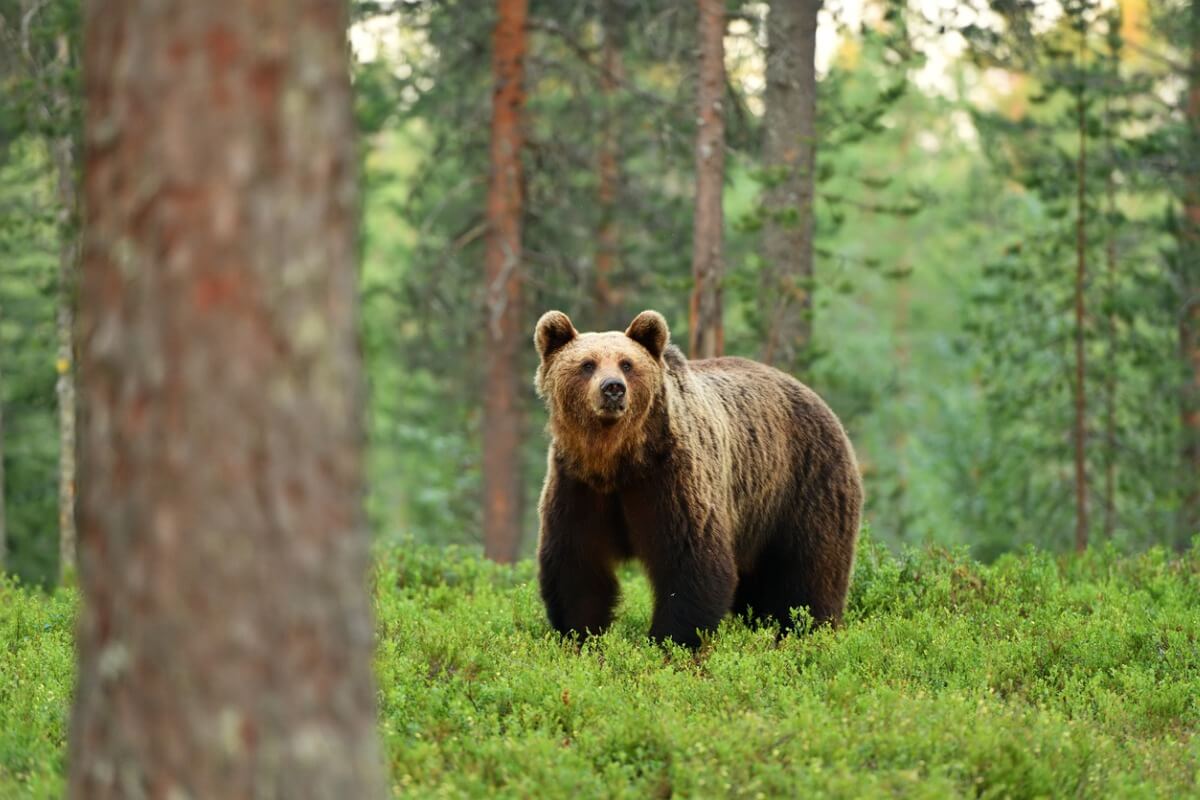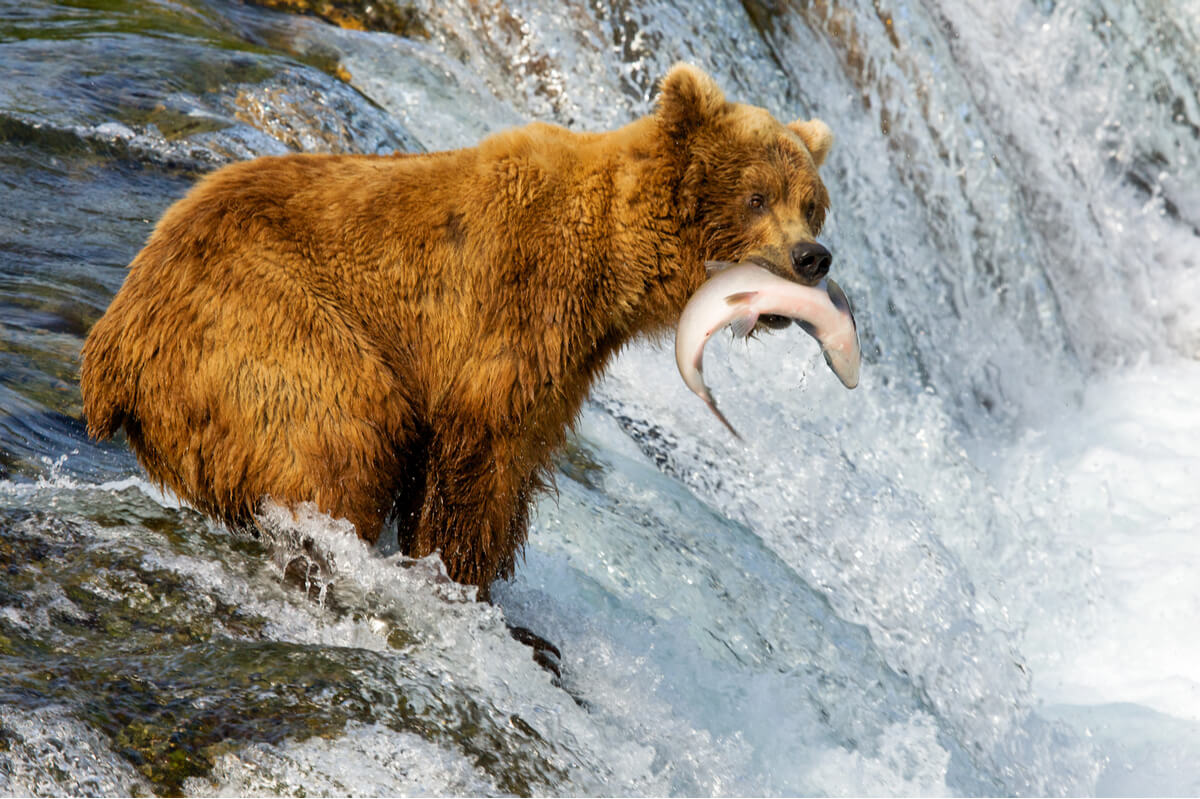Why Do Bears Like Salmon?

Even people who aren’t particularly interested in biology know that brown bears like salmon. The image of an ursid (Ursus arctos) on a stone hunting salmon that jump out of the water against the current is a picture that most of us are familiar with, as it’s part of many documentaries broadcast on television.
When we observe behavior like this in the animal kingdom, we can’t help but wonder why it takes place. In nature, nothing is left to chance or anecdotal: positive traits are selected, while negative ones disappear in time, so everything makes obvious sense. If you want to know more about the subject, keep reading.
The feeding of bears
In the first place, we should point out that we’re referring here to the brown bear (Ursus arctos), as the term “bear” actually encompasses 8 different species of the Ursidae family, which, in turn, are split into various subspecies. As you can imagine, an Asian bear and a polar bear will have very different dietary choices.
Brown bears are one of the most omnivorous mammals in the world and have been classified as the most cosmopolitan species of bear when it comes to food. These specimens feed almost exclusively on plant matter: 90% of their diet is based on flowers, fruits, cones, seeds, and shoots.
In addition to this, bears also eat insects, larvae, roots, small vertebrates, and can even hunt larger animals. You must take into account the corpulence and size of these mammals, something that makes it difficult to run in wooded environments full of vegetation. Therefore, bears rely on many more food sources than meat.

So why do bears like salmon?
As with everything in life, there are exceptions to the rule. In various areas of coastal Alaska and other regions, much of the diet of brown bears is based on salmon (genus Oncorhynchus). According to a study published in the journal Ecosphere, near-shore grizzly bears consume vastly more salmon than other foods.
To obtain these results, the feces of 886 grizzly bears – Ursus arctos horribilis, a subspecies of brown bear – were analyzed between 1995 and 2014 in British Columbia (BC), Canada. It was found that the specimens of this subspecies based their diet on salmon by 60%, while other species of ursids hardly eat fish.
Why? The answer is simple. Salmons migrate upstream from the ocean where they inhabit the high areas of mountain rivers, where they fertilize their eggs and have their offspring. On this countercurrent (anadromous) journey, salmon fall into the clutches of brown bears, eagles and many other predators.
As indicated by the explore.org portal, an adult male brown bear consumes, on average, almost 2,800 kilograms of salmon per year. This supposes an inestimable caloric intake and, therefore, the bears that base their diet on salmonids are much larger and heavier than those that specialize in fruits and vegetables.
The theory of optimal foraging and salmon consumption
This behavior can be easily explained by the theory of optimal foraging (TFO). According to this postulation, animals only eat what is energetically viable, that is, the food that provides them with more calories in consumption than they spend in the search or hunting of the resource.
It isn’t that bears “like” salmon as such. However, they give them such an incredible amount of calories compared to other foods and, in addition to this, they’re very easy to hunt during their migration. The effort that these animals spend waiting on the rocks of the river is minimal and the reward far exceeds the time spent.
About 100 grams of raw salmon contain 146 calories, while the same amount of strawberries only contains 33 calories. A bear – and any other omnivorous animal – will always choose the most energetic food if they have the option, as it maximizes their chances of survival given the same energy investment.
If other populations of grizzly bears don’t base their diet on salmon, it’s simply because they can’t do so. The migration of these fish is restricted to certain specific parts of the world, and those who aren’t lucky enough to have been born there will have to look for other types of food.
In addition to its caloric intake, salmon contains many proteins and Omega-3 fatty acids. In nature, this fish is a superfood.
Do bears eat honey?
The same theory can be applied when it comes to honey consumption. Bears have easy access to it because of their size, and this food gives them a lot of sugar and energy with minimal effort. Rather than loving the taste of it – which they do – the real reason they eat honey is because it pays off at an evolutionary level.

Bears do like salmon, but maybe not for the reasons you imagined. In nature, the concept of gastronomy doesn’t exist, as everything is based on the relationship between consuming and spending and energy. If a food has more calories than the energy needed to obtain it, then it makes sense for it to be part of the animal’s diet.
All cited sources were thoroughly reviewed by our team to ensure their quality, reliability, currency, and validity. The bibliography of this article was considered reliable and of academic or scientific accuracy.
- Adams, M. S., Service, C. N., Bateman, A., Bourbonnais, M., Artelle, K. A., Nelson, T., … & Darimont, C. T. (2017). Intrapopulation diversity in isotopic niche over landscapes: Spatial patterns inform conservation of bear–salmon systems. Ecosphere, 8(6), e01843.
- Van Daele, M. B., Robbins, C. T., Semmens, B. X., Ward, E. J., Van Daele, L. J., & Leacock, W. B. (2013). Salmon consumption by Kodiak brown bears (Ursus arctos middendorffi) with ecosystem management implications. Canadian Journal of Zoology, 91(3), 164-174.
- Hilderbrand, G. V., Hanley, T. A., Robbins, C. T., & Schwartz, C. C. (1999). Role of brown bears (Ursus arctos) in the flow of marine nitrogen into a terrestrial ecosystem. Oecologia, 121(4), 546-550.
This text is provided for informational purposes only and does not replace consultation with a professional. If in doubt, consult your specialist.